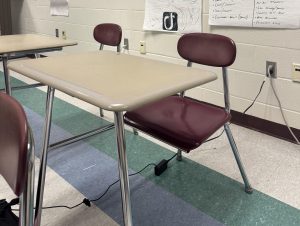Conflict in the Capitol
Jewel Samad/Getty Images
A sign placed on the lawn on the grounds of the Capitol Building displays that all National Parks are closed due to the government shutdown. The Speaker of the House in a press release this week said that “Families across the nation are still trying to recover from a month of missing paychecks and overdue bills.”
February 12, 2019
After conflict erupted in Washington D.C. between House Democrats and President Trump over funding for a disputed border wall, all “non-essential” government offices came to a halt for 35 days. The government shutdown officially started on Dec. 22, 2018 after disagreements among legislators in regards to border wall funding in the 2019 Federal Budget sparked a five week debate in Washington. The partial government closure resulted in the furlough of an estimated 800,000 federal employees including those of the I.R.S., U.S.D.A., N.P.S.
A multitude of government departments’ workforces have been affected by the events in the nation’s capital. The Washington Post reported a call-out rate of nearly 10% of T.S.A. agents on Jan. 21, which resulted in increased wait-times. However, it is to be noted that last year, the call-out rate of agents was recorded at 3.1%, and most locations affected didn’t occur at high-volume airports (Halsey & Laris). Another occurrence caused by understaffing at LaGuardia Airport in New York City led to flight delays throughout the Northeast Corridor.
A Congressional Budget Office report on the effects of the shutdown estimate the closure to have “delayed approximately $18 billion in federal discretionary spending,” and found that “[the] real GDP is estimated to be $8 billion lower” in the first fiscal quarter of 2019 than anticipated before the shutdown (C.B.O.). The document later notes that those most impacted from the closure were federal workers and private-sector entities, because some of them will “never recoup that lost income.”
Students responded to the shutdown, like Ram Senthilkumar ‘20 who said, “I’m normally conservative and can understand his [President Trump’s] immigration policy, but shutting down the government is not a good way of achieving it.” Senthilkumar later stated that he thought that “both parties should get their [expletive] together”, because he personally believes they’re both responsible and accountable for the partial closure. Lilliana Kelly ‘21 expressed that “Trump had the decision to [work] with the Congress, but instead he got all mad and 800,000 [Federal Workers] were left without pay.”
On Jan. 25, a resolution to temporarily fund government was signed by the President, and it officially reopened all government agencies affected by the shutdown. At a later speech in the Rose Garden at 1600 Pennsylvania Avenue, Trump said that “A bipartisan Conference Committee of House and Senate lawmakers and leaders will immediately begin reviewing the requests of our Homeland Security” (White House Press Release). A bipartisan debate pertaining to the future of U.S. immigration policy and border protection will be discussed in the House Committee on Appropriations and must propose and pass a bill before the Feb. 15 deadline to avoid another shutdown.














